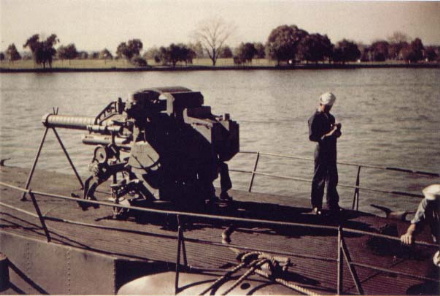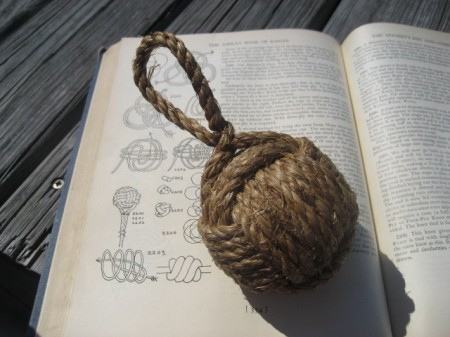
AN MK40 (5 INCH, 25 CALIBER) DECK GUN ON THE TOPSIDE OF THE USS ATULE (SS-403)
By JOHN R. BAKER
CHAPTER FOUR: AND NOW, ATULE’S FIRST DIVE . . .
Before being commissioned on June 21, 1944, the boat had to pass all her pre-commissioning tests, including that all-important first dive. Going out the channel that morning was certainly a pre-quel to one of the most important, memorable events of my life. I’m sure all of you who have ever participated on a first dive will agree it’s a never-to-be forgotten experience. Think about it.
Who could be absolutely sure another disaster like Squalus wouldn’t be about to happen?
The sound-powered phones were manned in all compartments and everyone enjoined to keep a sharp eye on developments. When we reached our diving area (not too deep, I’m sure) all the watertight doors throughout the boat were sealed tightly and the air conditioning flapper valves were made fast. Our safety and negative tanks were full and trim tanks were calculated to be topped off correctly. Everything was checked one more time.
The captain directed developments from the conning tower and spoke over the 1-MC. “Everybody ready? Here we go,” he said. COB Pyle checked the Christmas Tree carefully — making sure all the red and green signal lights were indicating correctly. “Open the main ballast vents!” A person can hear those vents cycle clear through the hull. You can even hear the rush of air out of the tank tops as salt water pours into voids on the tank bottoms. “Close the vents.” This after we were technically still on the surface. “All compartments report!” Up until that moment I had imagined we’d just “pull the plug” and let her rip and hope for the bet. This way might not be so bad, after all. All reports were favorable, so the order was repeated. “Open the vents!” This drill went on, a few feet at a time, until we were completely submerged and Captain Maurer could use the periscope. All told, it took almost a half hour to get completely under. Any problems with the boat must have been minor, at least that’s how I remember, and we headed back to the yard. All in all, it hadn’t been too bad a day. After that momentous occasion we went out day after day to test all the many things we had to know about O’Toole. Things such as speed on the surface and submerged, the proper operation of all our pumps, controls, gauges, etc. In other words, check out everything so as to give us complete trust in our boat and in our ability as a crew to master her operation.
Oh yes, we still looked forward to the very important “DEEP DIVE.” That’s when we must drop to our maximum depth. This was sort of in the nature of an aftermath. But, by the time we got to that test I know I for one wasn’t as concerned about my immediate future as I had been on that FIRST DIVE . . .
Commissioning day finally arrived. As previously mentioned, this was June 21, 1944. The entire crew, dressed in their dress blue uniforms fell into two rows facing each other on the narrow deck behind the conning tower. (They call that the sail now.) When the traditional ceremony was over we were all forever plank-owners on this USS Atule. Training went on constantly until it was time to head south. Our next stop was at Newport, Rhode Island, where we took on a load of torpedoes before continuing on to New London Sub Base. All manner of stores were put aboard here.
Somewhere along the way we took on one of the new MK40 deck guns that had been developed for submarines. It had a stainless steel barrel and didn’t have to be sealed every time we went under.
Another interesting thing happened when at last we cleared New London. Our complement called for two stewards mates to take care of the wardroom and the officers’ needs. Stewards were usually black and until Truman made changes they were the only blacks in a Navy crew. Ellis (ex Golden Glove champ) had served on other boats, but Griffith was brand new, and except for boot camp had no Navy training, certainly not submarine school. Anyhow, on our first after leaving New London (remember, we had put on a lot of stores, fuel, etc.) the unnamed diving officer apparently had not allowed for 12 tons of water ballast in our bow buoyancy tank. We went down shall I say head first. I know the forward bulkhead in the radio shack became the deck and I was standing on our main radio transmitter. If I’ve got this correct, Mr. Bowers, our executive officer, who happened to be in the control room, took over the dive, and by judicious tank-tank blowing and full motor reversal we leveled off before we struck bottom. Bear in mind, a submarine in that condition is like a train running down a steep grade — it goes faster and faster until the crash.
We were a little shook by this caper, but imagine how Griffith felt This was his very first dive! I heard that he fled into the wardroom pantry and pulled the curtain down over himself. If this was the way it was going to be he wanted off and right now! He did recover and soon became a popular member of the crew.
A big Navy school operated at Key West and new boats heading south were called in from time to time to operate with the school. By chance, we were chosen and soon we headed toward the same pier the boat we were relieving was vacating. We were now very close. The other boat had her lines singled up and their brow was still over. Just then, over a low knoll, came a motor scooter with two riders, hell bent for the pier. I swear, everyone on the submarine bridge was urging the motor scooter to hurry. The two guys ran up to the brow, dragged the scooter aboard and around behind the conning tower. Next, over the knoll came a shore patrol jeep with two irate cops. Too late. The boat left quickly and Atule rapidly moved in to occupy the vacated space.
Our week at Key West Base was an enjoyable interlude. I believe Sally Rand and her girls were appearing ? there.
When we crossed the Caribbean Sea I was intrigued by the beautiful light blue color of the water. We were on our way to Panama and the canal and we tried to be very alert. Possible German U-Boats. Going through the canal was enjoyable and we went through lock after lock and even had swim call in one of the lakes. Captain Jack had a machine gunner on the bridge protecting swimmers from sharks. No casualties.
Photo Credit:
MK40 deck gun photo provided by Richard Sanger

